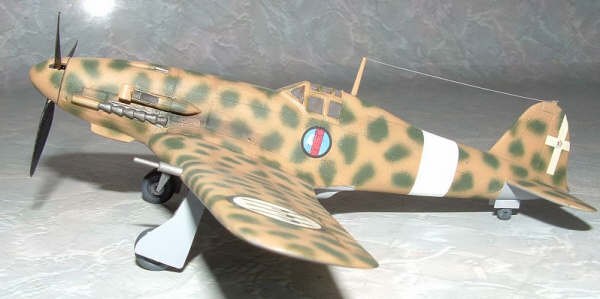
| KIT: | Frog 1/72 Fiat G.55 |
| KIT #: | ? |
| PRICE: | $ |
| DECALS: | Two options, both somewhat generic |
| REVIEWER: | Mark Fordham |
| NOTES: | An oldie but a goodie |

| HISTORY |
Toward the middle of 1942 or so, it was painfully obvious that the current crop of Italian fighters were losing ground on what the Allies were putting into the air. The biggest problem with Italian aircraft up to that point was the lack of a powerful engine and decent armament. The Italians made beautiful airframes that handled like a dream, but were slow because the Italian engine companies couldn't produce enough power.
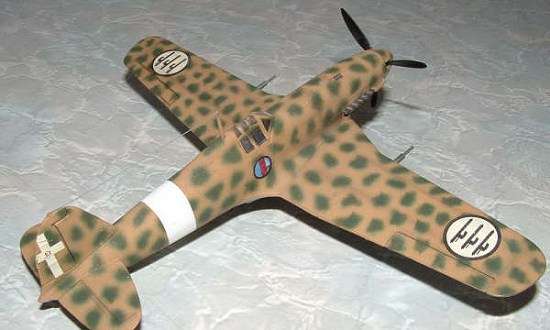 They were able to
use German DB.601 engines in some of their previous aircraft, but that
still limited the performance of the planes. This was because by the time
the Italians started using them in fighters, the Germans had gone on to
the next best thing. In terms of in-line engines, this was the DB.605
which started by producing nearly 1,500 hp, an increase of about 300 hp
over the DB.601s. The major airframe builders of Macchi, Reggiane, and
Fiat all put forth proposals for fighters using this engine. Macchi with
the C.205, Reggiane with the Re.2005 and Fiat with the G.55. Only Fiat's
entry was an all new airframe.
They were able to
use German DB.601 engines in some of their previous aircraft, but that
still limited the performance of the planes. This was because by the time
the Italians started using them in fighters, the Germans had gone on to
the next best thing. In terms of in-line engines, this was the DB.605
which started by producing nearly 1,500 hp, an increase of about 300 hp
over the DB.601s. The major airframe builders of Macchi, Reggiane, and
Fiat all put forth proposals for fighters using this engine. Macchi with
the C.205, Reggiane with the Re.2005 and Fiat with the G.55. Only Fiat's
entry was an all new airframe.
Naturally, the Italians decided to build all three. Their woefully inadequate production rates ensured that few of these planes would be available in any quantities and by the time the Italians surrendered in September of 1943, few had actually seen any sort of service. None of these were the Fiat G.55, the best of the lot. Fortunately for the Germans and the Fascist Italians in the North, the aircraft plants were mostly situated in Axis-held territory so many of these aircraft were available to the RSI. Even post war, the G.55 was produced for local use, for export and as the basis for the Merlin-powered G.59 trainer.
History courtesy of your editor who wrote it for another article!
| THE KIT |
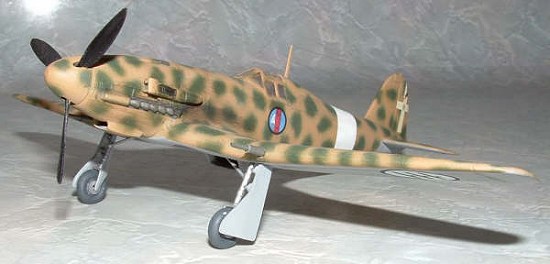 Following on the heels of the Airfix G50 I did a little while ago I decided
to break out the Frog G55 and finish of my collection of Fiat “G”
fighters, this kit along with quite a few other Frog/Novo kits was sent to
me by Derek Pendelton (thanks Derek) since I missed out on Frog kits when I
was a kid, :-)
Following on the heels of the Airfix G50 I did a little while ago I decided
to break out the Frog G55 and finish of my collection of Fiat “G”
fighters, this kit along with quite a few other Frog/Novo kits was sent to
me by Derek Pendelton (thanks Derek) since I missed out on Frog kits when I
was a kid, :-)
The G55 is typical Frog, basic shape and little detail, just like Airfix so instantly I fell in love with them. This particular aircraft was in the little plastic bag with the cardboard top with the painting instructions printed on the back of the card. Over the years the decals had succumbed to the ravages of time, humidity and sunlight and were toast.
| CONSTRUCTION |
Construction started with the careful removal of the cardboard top as I save these and Airfix ones, once safely packed away I assembled the cockpit, well glued the generic seat onto the generic pins and painted it generic green (after adding my homemade sidewalls and a floor from plastic card) I didn’t get too carried away as the transparencies on these old Frog kits are not the clearest.
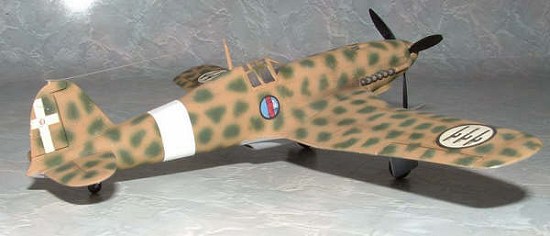 Considering the age of these Frog kits the fit on them is pretty good,
mind you unlike Airfix molds these haven’t churned out millions of copies
and are not on their 47th re-release so the mold is still
pretty sharp and the sink marks are at a minimum.
Considering the age of these Frog kits the fit on them is pretty good,
mind you unlike Airfix molds these haven’t churned out millions of copies
and are not on their 47th re-release so the mold is still
pretty sharp and the sink marks are at a minimum.
With the fuselage nicely sanded and groomed it was time to move onto the wings, gain trouble free assembly and only a small amount of sanding needed to clean up the leading edge joints. However when it came time to front up the wings to the fuselage there was quite a noticeable step that required a sliver of plastic card jammed into the end of the wing to force out the wings to a slightly wider profile, doing this eliminated the need to put a lot of filler on the wing roots and made hiding the gap a lot easier. With the addition of the tail-planes it was then time for an all over body massage with the 1200 wet-n-dry to remove the raised panel lines, once sanded I re-scribed new panel lines and added the undercarriage to the rather sparse undercarriage bay in preparation for the painting.
| COLORS & MARKINGS |
Frog
give you two versions on the decal sheet, a generic Italian version with
gray undersides and sand/green mottle or a really boring overall green
German bird, One thing that has always attracted me to Italian aircraft is
the cool desert camouflage, so it was a forgone conclusion that I would be
doing the sand and green scheme. I first sprayed both top and bottom
Tamiya Sky Gray to act as an undercoat and as the underside colour. Once
nice dry and smooth I masked off the underside areas and sprayed the sand
areas, once again leaving to dry for a day or two, the Green mottle was
done freehand with my battered old Paasche VSR-90 with a fine needle, now
no matter how hard I try I can never get 1/72nd scale
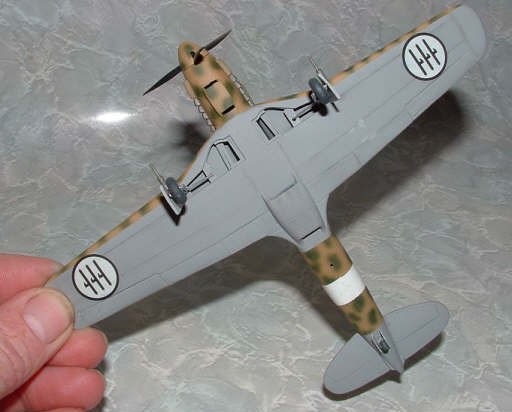 mottle to
look right, I always end up with too much overspray and splatter, I have
found that because my Paasche doesn’t seem to be happy with anything less
than about 22 PSI I cant thin my paints right down and have to have my
paint mixture quite thick otherwise it runs everywhere so I end up with a
slight splatter ring around the green.
mottle to
look right, I always end up with too much overspray and splatter, I have
found that because my Paasche doesn’t seem to be happy with anything less
than about 22 PSI I cant thin my paints right down and have to have my
paint mixture quite thick otherwise it runs everywhere so I end up with a
slight splatter ring around the green.
One thing that was interesting about this particular aircraft was the fact
that the propeller spinner was also mottled, I have to admit that it is
quite unusual and different, due to my limited reference material and the
fact that the G55 wasn’t the most well known Italian aircraft I had trouble
finding a lot on the G55 in regards to schemes so I had to rely on the Frog
instructions for most of the marking details. With the major painting out
of the way it was time to remove the masking tape and do the usual odd
touch up. The small details like undercarriage legs and wheels were painted
at this point and the gear doors were given a quick spray over with Sky
gray as I had (as usual) forgotten to paint them when I had the airbrush
loaded with gray the first time.
The Frog decals as mentioned had not suffered the passage of time well, I’ve used 35+ year old Airfix decals with no problems apart from being out of register, so I had to cobble together some out of my ever dwindling spares box, I managed to come up with just enough markings to let you know that the G55 is Italian but I was completely out of white numbers and letters so was unable to replace the number “1” on the side of the fuselage, as these fighters fought in the closing stages of the Italian conflict the three or four photos I could find of the G55 all show them without the white fuselage theater bands so common to most Italian aircraft.
With the painting and decaling done a thin coat of Humbrol Matt Kote was sprayed on in preparation for the weathering, but as these planes saw little if any combat I kept the weathering light and concentrated on exhaust stains and a little definition on the panel lines with a water colour wash, once dry a final coat of Matt Kote was sprayed on to seal the pastels and weathering and with the addition of the canopy another plane joins the shelves to sit there and gather dust, whitetail spider husks and fly crap.
| CONCLUSIONS |
Well I missed out on the
Frog kits when I was a kid, they weren’t readily available up here in the
north of New Zealand back in the early 70’s so I grew up on a diet of
Airfix and later Matchbox kits which as 9 year old had the same effect on
us as Tamiya 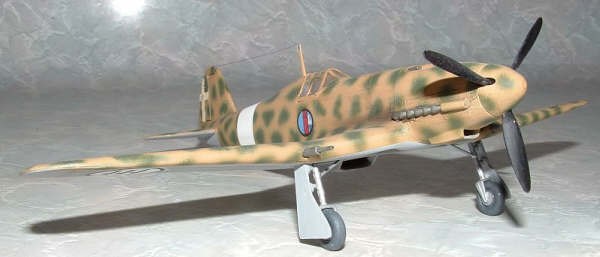 wunderkits have today, boy did we think the two or three
colour plastic sooooooooo cool! Or was that rad man? That Matchbox won our
hard earned pocket money and the Frog, what little was available and the
Airfix models just couldn’t compete against the yellow, green and calfs@#t
brown colours of Matchbox.
wunderkits have today, boy did we think the two or three
colour plastic sooooooooo cool! Or was that rad man? That Matchbox won our
hard earned pocket money and the Frog, what little was available and the
Airfix models just couldn’t compete against the yellow, green and calfs@#t
brown colours of Matchbox.
I cant say that building the G55 took me back to the days of my childhood (that for some reason the older I get the more I want to go back there) as I never experienced that many Frog kits but what I will say is that building the G55 gave me the same buzz that doing a series one Airfix kit did, easy to slap together with the minimum of fuss, sufferers of AMS or the newly diagnosed OTISM (Only Tamiya Is a Suitable Model, which at this point in time is incurable) will find their palms going sweaty at the mare thought of doing something as simple as these old Frog kits, they have raised panel lines for heavens sake! But they are fun and there are a lot of errhmmm “older” modelers that would have built tons of these little gems over the years.
Long live Airfix (and now Frog) and death to the heretics
January 2005
| REFERENCES |
Not a lot out there for the G55 on the WWW but you can Google G55.
Fighting Aircraft of WWII has one of the only colour photos of the G55 known to have survived plus a couple of colour profiles.
If you would like your product reviewed fairly and quickly by a site that has nearly 300,000 visitors a month, please contact me or see other details in the Note to Contributors.